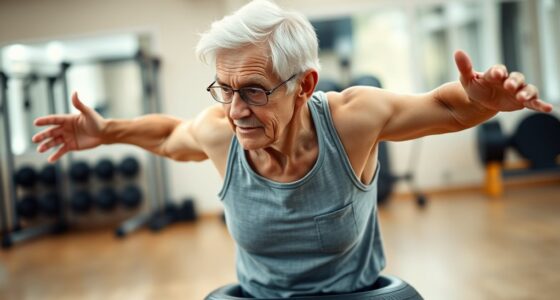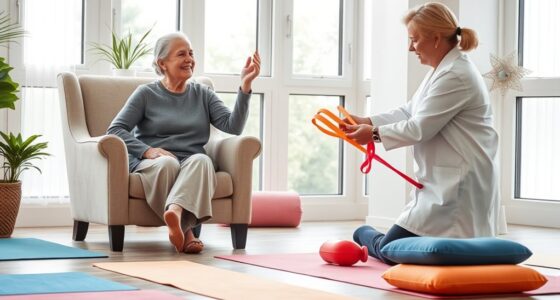While brushing your teeth, you can improve balance by practicing simple exercises like standing on one foot, shifting your weight side to side, and doing heel-to-toe walks. Lightly support yourself with a hand on the wall or sink for added stability. Incorporate gentle leg lifts and engage your core muscles to boost posture and coordination. Keep practicing these quick moves regularly, and you’ll discover even more ways to enhance your stability throughout the day.
Key Takeaways
- Incorporate standing on one foot to improve ankle stability during brushing.
- Use wall support to maintain balance while performing gentle shifts or leg lifts.
- Practice heel-to-toe walks in place for enhanced proprioception and core engagement.
- Shift weight side to side or perform lateral hip shifts to strengthen lateral stability.
- Engage core muscles consciously to support posture and improve overall balance while brushing.
Standing on One Foot

Have you ever considered how brushing your teeth can also improve your balance? Standing on one foot during your routine helps strengthen your ankles and improves stability. To do this, lift one foot off the ground and balance on the other, keeping your knee slightly bent. As you hold this position, focus on ankle strengthening by engaging the small muscles around your ankle joint. Incorporate leg stretches by gently stretching your lifted leg’s muscles to enhance flexibility and balance. Switch sides after a few seconds. This simple exercise not only boosts your core stability but also enhances leg strength. Over time, these small adjustments can notably improve your overall balance, making everyday movements safer and more controlled. Enhancing stability through simple exercises can also support overall skin health when combined with proper skincare routines.
Heel-to-Toe Walks
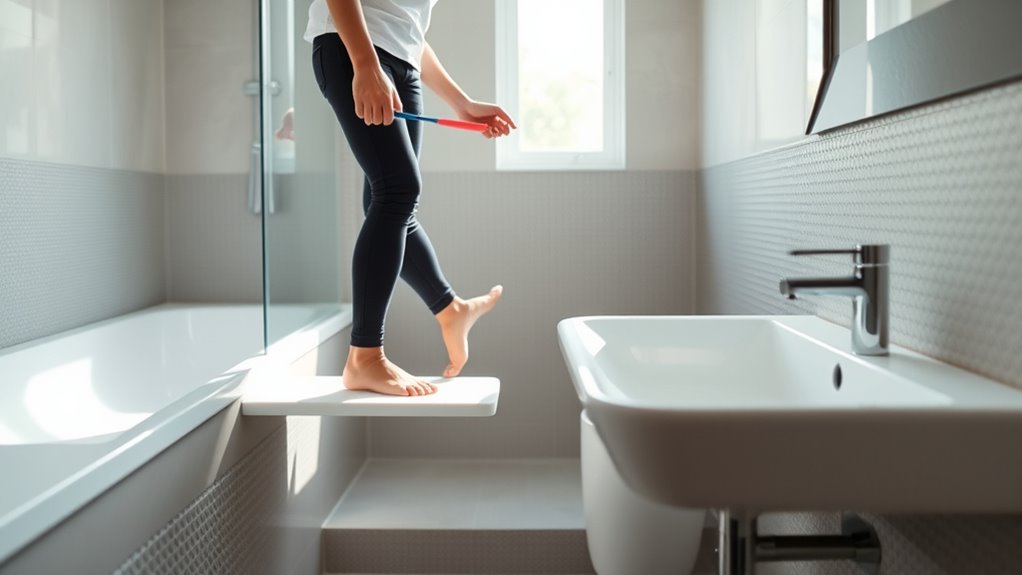
Heel-to-toe walks are a simple way to improve your balance while brushing your teeth. By carefully placing one foot directly in front of the other, you challenge your stability. This exercise can boost your overall balance and coordination over time.
Heel-to-Toe Walks
To improve your balance while brushing, try incorporating heel-to-toe walks into your routine. These walks help enhance your heel to toe alignment and strengthen your stabilizing muscles. As you brush, take slow, deliberate steps, placing your heel directly in front of your toes with each stride. Focus on maintaining a steady walking rhythm, keeping your movements controlled and even. This exercise challenges your balance by engaging your core and improving proprioception. You don’t need to rush; steady, mindful steps are most effective. Keep your posture upright, shoulders relaxed, and gaze forward. Doing heel-to-toe walks during brushing helps develop better balance and coordination, making everyday activities easier and safer. Plus, it’s simple to do without interrupting your routine.
Balance Enhancement
Incorporating heel-to-toe walks into your brushing routine can markedly enhance your balance by engaging your core and stabilizing muscles. These exercises boost proprioception, helping you sense your body’s position and improve balance coordination. To perform, walk slowly in a straight line, placing heel directly in front of toes with each step. Focus on steady movement and posture. Regular practice strengthens the muscles responsible for stability, reducing fall risk. Use the table below to understand key benefits and tips:
| Benefit | Tip |
|---|---|
| Improves balance coordination | Maintain a straight line while walking |
| Enhances proprioception exercises | Focus on a fixed point ahead |
| Strengthens stabilizing muscles | Keep arms relaxed at sides |
| Develops body awareness | Practice daily for best results |
Additionally, engaging in balance exercises like heel-to-toe walks can improve your overall stability and confidence in daily activities.
Balancing With a Hand on the Wall

Using the wall for support can help you maintain balance and build confidence during your exercises. Make sure your hand is positioned comfortably at waist level or slightly higher for stability. Proper hand placement guarantees you stay safe and get the most benefit from this simple balancing technique. Incorporating balance exercises into your routine can improve overall stability and coordination.
Wall Support Benefits
Supporting yourself with a hand on the wall while balancing during brushing can substantially improve stability. This wall support benefits your ability to stay upright and safe, especially if your balance isn’t perfect. Using the wall provides a steady anchor, allowing you to focus on brushing without worry of falling. Additionally, practicing balance exercises while brushing can help improve your overall stability over time.
Proper Hand Placement
Placing your hand correctly on the wall is essential for maintaining proper balance while brushing your teeth. Proper hand positioning helps you stay steady and focus on the task. Keep your hand flat against the wall, with fingers comfortably spread, to maximize support. Your toothbrush grip should be firm but relaxed, ensuring control without tension. Remember, a good hand placement reduces strain and improves stability during balancing exercises. Use the table below to remember key points:
| Hand Positioning | Toothbrush Grip |
|---|---|
| Flat hand, fingers spread | Gentle grip, not too tight |
| Maintain contact lightly | Control without pressure |
| Keep hand steady | Avoid gripping too hard |
| Rest hand comfortably | Ensure relaxed grip |
Practicing proper hand placement makes balancing safer and more effective. Additionally, understanding balance techniques can further enhance your stability during these exercises.
Knee Bops for Stability

To improve your stability while brushing your teeth, try incorporating knee bops into your routine. This simple move helps enhance knee stability and joint flexibility. Here’s how to do it:
- Stand with feet shoulder-width apart and bend your knees slightly.
- Bop your knees gently side to side, engaging your leg muscles.
- Keep your core tight and maintain good posture throughout.
- Incorporate smart marketing techniques by sharing your progress on social media to stay motivated and accountable.
Knee bops target your knee joint, boosting stability and reducing the risk of wobbling. They also promote joint flexibility, making everyday movements easier. Doing these bops regularly while brushing keeps you active and improves balance without much effort. Remember, the key is to move smoothly and control your bops, focusing on engaging your leg muscles. This quick exercise can lead to noticeable improvements in your overall stability over time.
Toe Raises While Brushing

While you’re brushing your teeth, adding toe raises can boost your balance and strengthen your lower legs. Simply lift your heels off the ground, rising onto your toes, then lower back down. This movement improves ankle flexibility, which is key to maintaining stability throughout the day. As you perform toe raises regularly, you’ll also build toe strength, helping you better control your movements and prevent falls. Keep your movements controlled and focus on engaging your calves and toes. You can do this quietly and efficiently without interrupting your brushing routine. Over time, these simple toe raises will enhance your balance, making daily activities easier and reducing your risk of imbalance-related injuries. Incorporating protective styling benefits from crochet techniques can also support your overall hair health during your fitness routines. It’s an easy, effective way to turn your brushing time into a quick balance boost.
Shifting Weight Side to Side
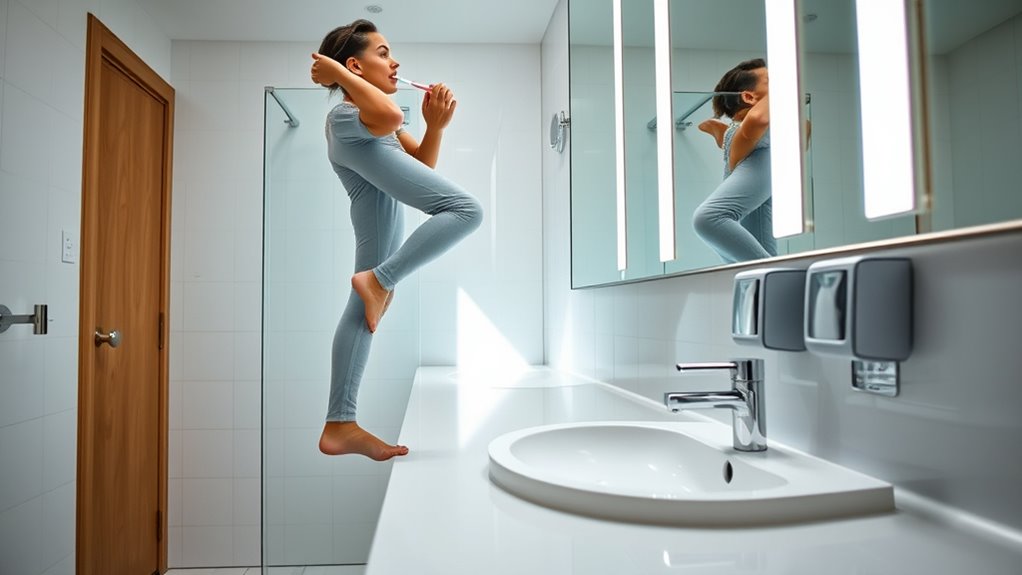
After lifting your heels for toe raises, shift your weight smoothly from one foot to the other side to improve lateral balance. This movement enhances ankle flexibility and helps maintain proper posture alignment during daily activities. To do this effectively:
- Keep your core engaged and focus on controlled movements.
- As you shift, ensure your hips stay level and your shoulders remain relaxed.
- Repeat side to side, feeling the stretch and strengthening your stabilizing muscles.
- Incorporating balance exercises into your routine can further improve your overall stability and coordination.
This simple exercise promotes better balance, boosts ankle flexibility, and encourages proper posture, making your everyday movements more stable. Practice this steadily while brushing your teeth, and you’ll notice improved lateral stability over time.
Gentle Leg Lifts
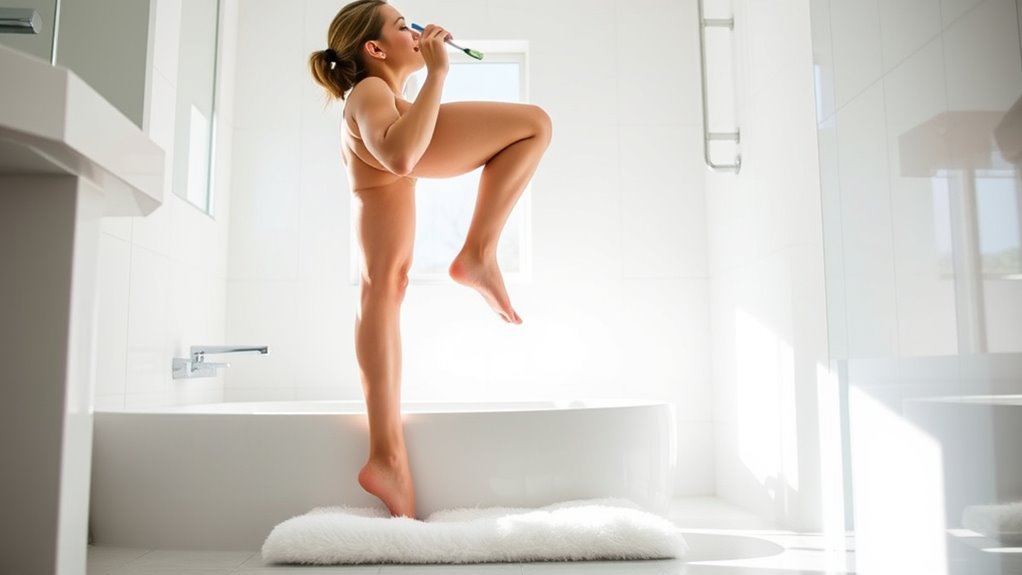
Adding gentle leg lifts to your brushing routine can strengthen your leg muscles and improve overall stability. Start by holding onto the sink or a sturdy surface for balance. Lift one leg slowly, keeping your knee straight, and hold for a few seconds. Lower it gently and switch legs. Incorporate gentle stretches by extending your leg fully during each lift, feeling muscle activation in your thighs and hips. This exercise not only engages your leg muscles but also enhances your balance. Focus on controlled movements rather than speed to maximize benefits. Doing these lifts regularly helps build strength, improves coordination, and supports better posture. You can do several reps while brushing, making your routine more effective without taking extra time. Being mindful of your body awareness can further optimize these exercises and prevent injury.
Engaging Core Muscles During Stance

Engaging your core muscles during your stance while brushing helps improve stability and posture. When you focus on core engagement, you support proper posture alignment, reducing strain on your neck and back. To do this effectively:
Engage your core during brushing to boost stability and support proper posture daily.
- Tighten your abdominal muscles gently as you stand, keeping your spine straight.
- Imagine pulling your belly button toward your spine without holding your breath.
- Maintain this tension while shifting your weight slightly from one foot to the other to challenge balance.
- Be mindful of muscle activation to ensure you are engaging your core properly throughout the activity.
This active engagement not only enhances your balance but also strengthens your core over time. Remember, consistent core engagement during daily activities like brushing teeth makes a noticeable difference in your overall stability and posture health.
Frequently Asked Questions
Can These Exercises Improve Overall Balance for Daily Activities?
You might wonder if these balance exercises can improve your daily activities. They can help strengthen your core and enhance stability, making everyday movements easier. While practicing good dental hygiene and oral health is important, incorporating balance exercises into your routine boosts overall coordination and reduces fall risks. By doing these exercises regularly, you’ll notice better posture, stability, and confidence in your daily tasks, contributing to your overall well-being.
How Often Should I Perform These Balance Exercises During Brushing?
Think of your balance exercises as tiny anchors for your stability ship. To keep your balance steady, aim for daily practice during brushing. Follow the frequency guidelines of doing these exercises at least once a day, and keep your exercise duration brief—about 30 seconds to a minute. Consistency turns these small efforts into powerful waves of improvement, helping you stay steady on your feet through life’s unpredictable currents.
Are These Exercises Suitable for Seniors or Those With Mobility Issues?
You wonder if these exercises are suitable for seniors or those with mobility issues. These balance exercises can be made senior friendly and mobility adapted to accommodate different needs. You should consult a healthcare professional first, but gentle modifications, like holding onto a sturdy surface or doing seated exercises, make them safe. Always listen to your body and avoid pushing beyond your comfort zone to prevent falls or injuries.
Do I Need Special Footwear or Equipment to Do These Exercises?
Oh, sure, you need fancy footwear or exercise equipment for balancing while brushing—just kidding! You don’t need special footwear or equipment, just your usual shoes or even barefoot if you prefer. The idea is to focus on your balance, not gear up like you’re heading to a gym. Keep it simple, safe, and effective—no need for extra gear, just your body and a bit of focus.
Can These Exercises Help Prevent Falls in Older Adults?
Yes, incorporating balance exercises into your daily routine can help prevent falls in older adults. When you improve your stability through simple movements, you reduce the risk of accidents. Plus, maintaining good dental hygiene and oral health supports overall well-being, which can boost confidence and mobility. These exercises don’t require special equipment, making it easy to stay active and safe at home, ultimately helping you stay independent longer.
Conclusion
By incorporating these balance exercises into your brushing routine, you’re turning a mundane task into a powerhouse of stability. Imagine transforming your daily habit into a secret weapon that could make you feel like you’re walking on air! Stick with it, and you’ll notice your balance improving faster than you ever thought possible. So next time you brush, remember—you’re not just cleaning teeth, you’re building a stronger, more confident you with every swipe.


